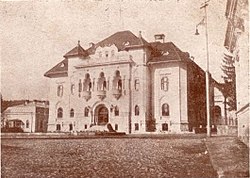Top Qs
Timeline
Chat
Perspective
Muscel County
County in Romania From Wikipedia, the free encyclopedia
Remove ads
Muscel County is a former first-order administrative district of Romania. It was located in the southern central part of Greater Romania, in the northwestern part of the historic region of Muntenia. Its territory is now mostly part of Argeș County, while some communes (Malu cu Flori, Pucheni and Văleni-Dâmbovița) now belong to Dâmbovița County. The county seat was Câmpulung.
The county was bordered on the west by Argeș County, to the north by the counties of Făgăraș and Brașov, and to the east by Dâmbovița County.
In 1938, the county was disestablished and incorporated into the newly formed Ținutul Argeș, but it was re-established in 1940 after the fall of Carol II's regime – only to be abolished on 6 September 1950 by the Communist regime.
Remove ads
Administrative organization


Administratively, Muscel County was originally divided into two districts (plăși):[1]
- Plasa Podgoria
- Plasa Radu-Negru
Subsequently a third district was established:
- Plasa Râul Doamnei
By 1938, the county was divided administratively into six districts:
- Plasa Argeșel
- Plasa Dâmbovița
- Plasa Podgoria
- Plasa Râul Doamnei
- Plasa Râurile
- Plasa Golești
Remove ads
Population
According to the 1930 census data, the county population was 149,797 inhabitants, ethnically divided as follows: 97.1% Romanians, 2.3% Romanies, 0.2% Hungarians, as well as other minorities. From the religious point of view, 99.3% Orthodox, 0.3% Roman Catholic, as well as other minorities.
Urban population
In 1930, the county's urban population was 13,868 inhabitants, ethnically divided as follows: 95.4% Romanians, 1.2% Hungarians, 0.9% Romanies, 0.5% Germans, as well as other minorities. From the religious point of view, the urban population was composed of 95.8% Eastern Orthodox, 2.2% Roman Catholic, 0.6% Reformed (Calvinist), 0.4% Evangelical (Lutheran), 0.3% Baptist, 0.2% Greek Catholic, as well as other minorities.
Remove ads
Industry
A paper factory (Câmpulungul S. A.) functioned within the county seat, the town of Câmpulung, as of 1931.[2]
References
External links
Wikiwand - on
Seamless Wikipedia browsing. On steroids.
Remove ads



